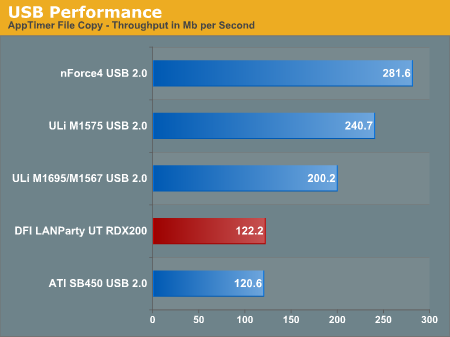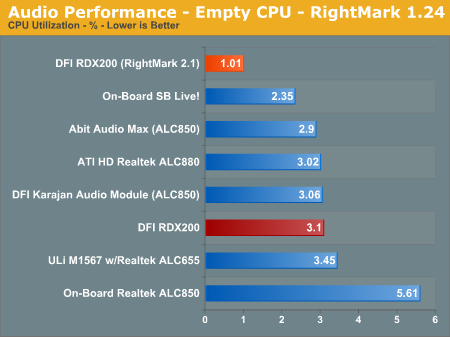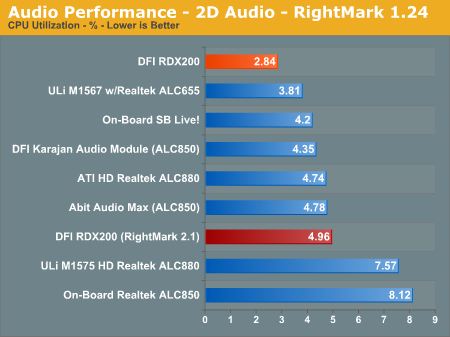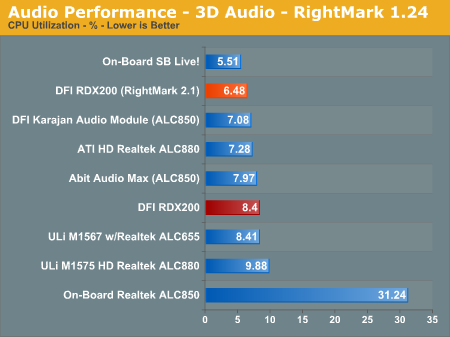DFI LANParty UT RDX200: ATI’s Crossfire AMD for the Bleeding Edge
by Wesley Fink on October 18, 2005 11:03 AM EST- Posted in
- Motherboards
Performance of Features
When you receive a board Friday afternoon that will go on sale Tuesday morning, there is sometimes just not enough time to complete all the tests that you initially planned. In the interest of bringing you the most significant test results on the DFI RDX200, we concentrated on two areas of interest, specifically USB Performance and CPU utilization of the Karajan audio module.
For additional information on the performance of other Storage, Ethernet, and Firewire, please go to other recent ATI Rx480/482 reviews at "ATI's Crossfire: Best Overclocker on the Market?" and "Sapphire PURE Innovation - ATI's Chipset for the AMD Enthusiast". The performance of the feature accessory chips present on the DFI RDX200 are tested in those reviews.
USB Performance
USB has been a problem area for the ATI SB450 chipset, so we decided to see if anything had changed. We ran our standard USB throughput test on the DFI using an external USB hard drive.
Our test method uses a RAM disk as our "server", since memory removed almost all overhead from the serving end. We also managed to turn off disk caching on the USB and Firewire side by setting up the drives for "quick disconnect" and our results were then consistent over many test runs.
We use just 1GB of fast 2-2-2 system memory set up as a 450MB RAM disk and 550MB of system memory. Our stock file is the SPECviewPerf install file, which is 432,533,504 bytes (412.4961MB). After copying this file to our RAM disk, we measured the time for writing from the RAM disk to our external USB 2.0 or Firewire 400 or Firewire 800 drive using a Windows timing program written for AnandTech by our own Jason Clark. The copy times in seconds were then converted into Megabits per second (Mb) to provide a convenient means of comparing throughput. Higher Rates, therefore, mean better performance.
There is an alternative in the ULi M1575 southbridge, which we recently tested. The ULi SB provides competitive USB performance and the SATA2 ports, which are missing from the ATI SB450 - and it is available today. We asked DFI why they chose the SB450 instead and they responded that the design work for the RDX200 was far along when the M1575 became an alternative. DFI also pointed out that M1575 and SB450 are not pin-compatible, thus making a last minute change in southbridge to be a very costly option. The SB600 should be pin-compatible with SB450, as M1575 is pin-compatible with M1573. When the SB600 is available, DFI will use the SB600 instead. They may also consider an SB change in their upcoming ATI dual x16 motherboard.
Audio Performance
For audio testing, we used Rightmark 3D Sound CPU utilization test, which is the same benchmark run in our earlier nForce4 SLI and Ultra roundups. This benchmark measures the overhead or CPU utilization required by a codec or hardware audio chip. We tested performance both with the earlier version 1.24 that we had used for past testing and the latest version 2.1. As you will see, 2.1 does yield different performance numbers.
It is very important to point out that the DFI LANParty UT RDX200 is the first Athlon 64 retail motherboard to deliver Azalia High Definition audio. Those who have been complaining about the poor AC'97 audio present on most AMD boards should be very pleased to find Azalia HD on the ATI chipset boards.
DFI claims that the Karajan module lowers noise using an on-board audio solution. We did some subjective listening tests with the DFI's version of Azalia HD through a Dolby amplifier and a 5.1 speaker setup. We really couldn't hear a huge improvement over our last listening tests of ATI Azalia HD. Perhaps that was because our last experience with Azalia HD on AMD was so good. HD really is in a completely different league from the other audio solutions that we have tested on Athlon 64. Noise was virtually non-existent, and imaging and depth were superb when listening to demanding CDs. The same CD sounded thin, noisy, and artificial through a more common ALC850 fed to the same Dolby amp and 5.1 speakers. This is not to say that the Azalia HD is at the same level as the very best audio cards, but it is a lot closer than you might think.
When you receive a board Friday afternoon that will go on sale Tuesday morning, there is sometimes just not enough time to complete all the tests that you initially planned. In the interest of bringing you the most significant test results on the DFI RDX200, we concentrated on two areas of interest, specifically USB Performance and CPU utilization of the Karajan audio module.
For additional information on the performance of other Storage, Ethernet, and Firewire, please go to other recent ATI Rx480/482 reviews at "ATI's Crossfire: Best Overclocker on the Market?" and "Sapphire PURE Innovation - ATI's Chipset for the AMD Enthusiast". The performance of the feature accessory chips present on the DFI RDX200 are tested in those reviews.
USB Performance
USB has been a problem area for the ATI SB450 chipset, so we decided to see if anything had changed. We ran our standard USB throughput test on the DFI using an external USB hard drive.
Our test method uses a RAM disk as our "server", since memory removed almost all overhead from the serving end. We also managed to turn off disk caching on the USB and Firewire side by setting up the drives for "quick disconnect" and our results were then consistent over many test runs.
We use just 1GB of fast 2-2-2 system memory set up as a 450MB RAM disk and 550MB of system memory. Our stock file is the SPECviewPerf install file, which is 432,533,504 bytes (412.4961MB). After copying this file to our RAM disk, we measured the time for writing from the RAM disk to our external USB 2.0 or Firewire 400 or Firewire 800 drive using a Windows timing program written for AnandTech by our own Jason Clark. The copy times in seconds were then converted into Megabits per second (Mb) to provide a convenient means of comparing throughput. Higher Rates, therefore, mean better performance.

There is an alternative in the ULi M1575 southbridge, which we recently tested. The ULi SB provides competitive USB performance and the SATA2 ports, which are missing from the ATI SB450 - and it is available today. We asked DFI why they chose the SB450 instead and they responded that the design work for the RDX200 was far along when the M1575 became an alternative. DFI also pointed out that M1575 and SB450 are not pin-compatible, thus making a last minute change in southbridge to be a very costly option. The SB600 should be pin-compatible with SB450, as M1575 is pin-compatible with M1573. When the SB600 is available, DFI will use the SB600 instead. They may also consider an SB change in their upcoming ATI dual x16 motherboard.
Audio Performance
For audio testing, we used Rightmark 3D Sound CPU utilization test, which is the same benchmark run in our earlier nForce4 SLI and Ultra roundups. This benchmark measures the overhead or CPU utilization required by a codec or hardware audio chip. We tested performance both with the earlier version 1.24 that we had used for past testing and the latest version 2.1. As you will see, 2.1 does yield different performance numbers.



It is very important to point out that the DFI LANParty UT RDX200 is the first Athlon 64 retail motherboard to deliver Azalia High Definition audio. Those who have been complaining about the poor AC'97 audio present on most AMD boards should be very pleased to find Azalia HD on the ATI chipset boards.
DFI claims that the Karajan module lowers noise using an on-board audio solution. We did some subjective listening tests with the DFI's version of Azalia HD through a Dolby amplifier and a 5.1 speaker setup. We really couldn't hear a huge improvement over our last listening tests of ATI Azalia HD. Perhaps that was because our last experience with Azalia HD on AMD was so good. HD really is in a completely different league from the other audio solutions that we have tested on Athlon 64. Noise was virtually non-existent, and imaging and depth were superb when listening to demanding CDs. The same CD sounded thin, noisy, and artificial through a more common ALC850 fed to the same Dolby amp and 5.1 speakers. This is not to say that the Azalia HD is at the same level as the very best audio cards, but it is a lot closer than you might think.










48 Comments
View All Comments
JarredWalton - Tuesday, October 18, 2005 - link
SATA2 actually only increases the bandwidth from 1.5Gbps to 3.0Gbps. Since sustained transfer rates are still maxing out at around 100MBps (0.8Gbps), and that's only with RAID-0 and two drives... well, SATA2 isn't a huge deal. I don't recall seeing whether the ATI chipset supports NCQ, which is of course in a similar boat.USB2.0 performance is only really important if you use an external HDD. Most flash cards and other USB2.0 devices don't come anywhere near 60MBps, as Anand's USB Flash Drive article showed. USB2.0 video devices might also have trouble, though - not sure what the throughput on those is. 150Mbps should be enough, really. Isn't 1080i only a 20Mbps stream? (Or is it 20MBps?)
haelduksf - Wednesday, October 19, 2005 - link
Err...that's what I meant, 3 Gbps, not 300Mbps. in either case, it's quite useless, and will be for the forseeable future.erinlegault - Tuesday, October 18, 2005 - link
I would have been nice if DFI would have used the ULI southbridge. Maybe DFI will include the ULI M1575 for the DFI LANParty UT RDX200 Expert motherboard (that's if they do the same as they've done with the NF4 board).DigitalFreak - Tuesday, October 18, 2005 - link
Anyone else think this board is a bit lacking feature wise for the $230 asking price? If you REALLY want Crossfire, then you'll need this board. Otherwise, the Nforce4 seems to be the better choice. I just can't believe that DFI is asking so much $$$ for this!mongoosesRawesome - Tuesday, October 18, 2005 - link
price will likely come down pretty quickly. remember how much the nforce 4 sli boards were when they came out?I've also heard rumors that DFI is going to release a new board with an updated southbridge in a few weeks.
bob661 - Tuesday, October 18, 2005 - link
Only if people buy these things otherwise there would be no reason to lower prices.coomar - Tuesday, October 18, 2005 - link
226-2-2-2-7-2T is going to be faster than 206-2-2-2-7-1Tvdimm and vcore voltage choices were very impressive
how good is azalia compared to good soundcards/ decoders?
muffin - Tuesday, October 18, 2005 - link
DFI was not the first! EQS have had a board on sale at overclock.co.uk for a couple of weeks now. Its the same as the (as yet unreleased) Sapphire board, made by the same people.Linky: http://www.overclock.co.uk/customer/product.php?pr...">http://www.overclock.co.uk/customer/product.php?pr...
Its been on sale for a while guys, pay attention. Theres an Inquirer story about it too :/
erinlegault - Tuesday, October 18, 2005 - link
There is data for x850XT missing in the Half-Life 2, Wolfenstein, Aquamark and UT2004Wesley Fink - Tuesday, October 18, 2005 - link
Due to time constraints we did not run a full set of Crossfire benchmarks. We were mainly trying to confirm Crossfire worked as it should on the DFI. We therefore ran those benches where more powerful video makes a difference and left out those where the video power makes little difference. You can find a full suite of Crossfire, 7800GTX, and other graphics benchches in our Crossfire Graphics launch reviews under the Video tab at the top of the page.We did intend to run Half Life 2 but our benchmarks no longer work with the new build Steam forces on you. We are in the process of updating the HL2 benchmark unless some of you tech wizards know of an HL2 benchmark that will definitely work with the new HL2 version.